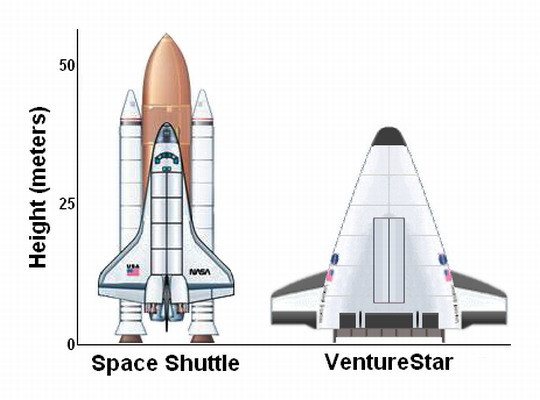At the end of the 20th century, the United States government was already set to developing a reusable space plane to replace the aging Space Shuttle program. The resulting launch vehicle would be able to launch satellites into orbit as 1/10th of the cost, while also having the ability to carry passengers up. Funded by the federal government, it was Lockheed Martin who started development of the X-33 at its Skunk Works facility in 1996, the same facility that saw the development of the revolutionary U2 and SR-71 Blackbird spy planes . The space ship, which became known as the VentureStar, showed great promise. As a single-stage-to-orbit reusable launch system existing of a lifting body-wing design with no expendable parts, it would launch vertically. But the ship would return to Earth landing like an airplane and because it was lighter by design, it would be able to land at virtually any major airport in case of emergency unlike the Space Shuttle which required much longer runways than those publicly available.

The design would mean considerable savings in time and materials as well as just being safer in general with maintenance happening similar to that of an airplane. Hard to believe, but the Shuttle required around 17,000 man-hours after every flight to check and if needed replace the thousands of heat-resistant ceramic tiles. The VentureStar on the other hand would use a new metallic thermal protection system, which would be much easier and cheaper to maintain. Then there was the basic design of the vehicle, which meant no more large external tank needed for launch, and neither did it need additional booster rockets that had to be recovered from the ocean after launch. Then there was the new engine technology. Unlike the Shuttle which relied on conventional nozzle engines, the VentureStar project would use linear aerospike engines that maintain thrust efficiency at all altitudes and were developed to have thrust reserve just in case things went wrong. Should one of the engines ever have failed, first the opposite engine would immediately shuf off to counterbalance and keep the vehicle going in the right direction. Next, that reserve would mean that the remaining engines were powerful enough to throttle up and ensure the space ship would still safely reach orbit.
Last but not least VentureStar’s main fuels would have been only liquid hydrogen and liquid oxygen, meaning the exhaust of its engines would have been composed of… water vapor. It was truly next-generation tech! Unfortunately, it wasn’t meant to be. Due to spiraling costs, and technical difficulties, NASA scrapped their support for the program in 2001. For Lockheed Martin it didn’t make sense anymore to continue the program on its own and so, VentureStar was scrapped with the prototype 90% complete. Perhaps it did show however that the future of space transportation and exploration would have to be corporate. Ironically that is what Lockheed Martin was attempting to achieve with VentureStar.
After suborbital flights kicking of next year with Virgin Galactic and XCOR to name a few, one of the next logical steps for these pioneers will be to reach orbit and who knows, maybe some day we will see another VentureStar rising from the ashes.









